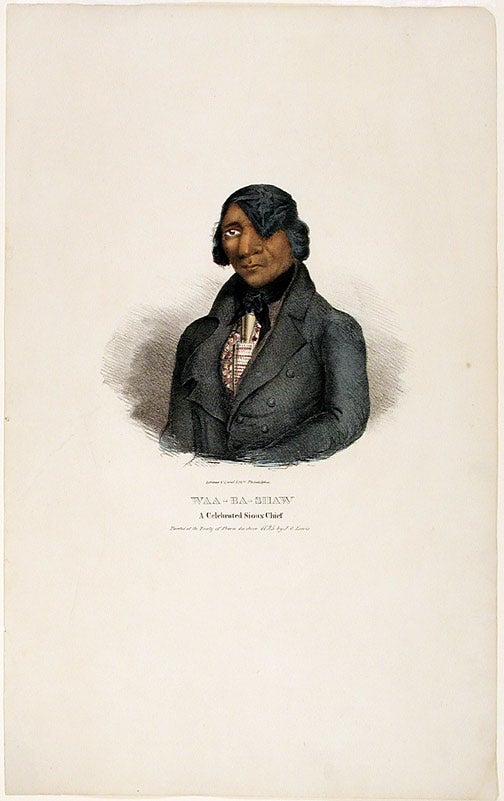LEWIS, After James Otto (1799-1858)
Waa-Ba-Shaw A Celebrated Sioux Chief. Painted at the Treaty of Prarie de Chien 1825 by J.O. Lewis
[Philadelphia: published by the author, 1835-36]. Lithograph, coloured by hand, printed by Lehman & Duval of Philadelphia. Sheet size: 17 11/16 x 11 inches.
A striking image from Lewis's "Aboriginal Portfolio."
Waa-Pa-Shaw, better known as Wabasha, was chief of a Kiowa tribe of the Mdewakanton Sioux. He was treated with great respect by all the Sioux. He recommended non-resistance to the whites, though he and his people were removed twice to new settlements. He was described by General Whiting in 1820 as a small man with an eyepatch, "but who walked about with the air of an ancient king." (Horan). He was the first Native signer of the Prairie de Chien Treaty, indicating his importance among the assembled chiefs. The Aboriginal Portfolio represents the first attempt to publish a collection of portraits of North American Indians preceding the works of Catlin, and McKenney and Hall. It is also one of the earliest large projects in American lithography, and one of the first large visual works to deal with subjects beyond the east coast of the United States. The Aboriginal Portfolio was originally published in Philadelphia, for the author, by lithographers George Lehman and Peter S. Duval. It was issued in parts, ten parts of eight plates each being issued; however, due to a loss of subscribers, very few of the last few parts were issued. James O. Lewis was born in Philadelphia in 1799, moved west as a teenager, and had become an engraver and painter by the time he lived in St. Louis in 1820. In 1823 he moved to Detroit, and painted the first of his Indian portraits at the request of Gov. Lewis Cass of Michigan. He accompanied Cass on four Indian treaty expeditions in the Great Lakes region in 1825-27 and painted Indians in the course of each. Virtually all of Lewis's portraits were derived from these meetings. Subsequently, many of the Lewis originals were copied by Charles Bird King, and some appeared in the King versions in the McKenney and Hall portfolio. All of the Lewis originals were destroyed in the Smithsonian fire of 1865.
Cf. Bennett, p.68; cf. Eberstadt 131:418; cf. Field 936; cf. Sabin 40812; cf. Howes J135; cf. Reese, Stamped With A National Character 23.
Item #17733
Price: $350.00


